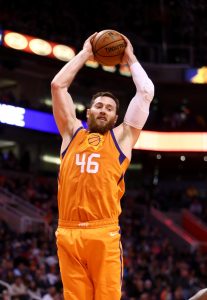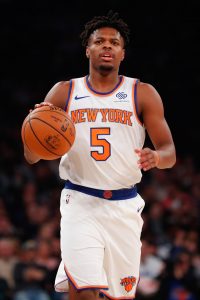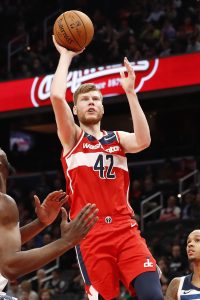Most players around the NBA are now eligible to be traded, with just a few exceptions. However, there are several players who can’t be dealt to specific teams this season.
NBA rules prohibit a team from trading for a player if the team traded that player away earlier in the season or during the previous offseason. In other words, if a club traded a player between the end of last year’s NBA Finals and today, it’s not eligible to reacquire him in a deal on or before February 6.
This rule doesn’t apply if a player who was traded since last spring’s Finals was subsequently waived and then signed with a new team. For instance, the Jazz and Grizzlies both traded away Kyle Korver last summer. Korver was later waived by the Suns and signed with the Bucks. If he had remained in Phoenix, Korver would be ineligible to be acquired by Utah or Memphis, but that restriction was lifted once he signed with Milwaukee.
The rule also doesn’t apply to players whose draft rights were traded. For example, the Suns would technically be eligible to reacquire Jarrett Culver from the Timberwolves after trading his draft rights to Minnesota last summer.
For the most part, these restrictions won’t affect teams’ plans — it’s not as if the Pelicans will be looking to reacquire Anthony Davis from the Lakers. Still, some of them are worth noting. If the Celtics seek frontcourt help on the trade market, for instance, they’ll have to be aware of the fact that they can’t reacquire Aron Baynes.
Here’s the full list of players who are ineligible to be reacquired via trade by specific teams during the 2019/20 regular season:
Atlanta Hawks
- Can’t reacquire Kent Bazemore (Kings), Allen Crabbe (Timberwolves), Solomon Hill (Grizzlies), Taurean Prince (Nets), or Omari Spellman (Warriors)
Boston Celtics
- Can’t reacquire Aron Baynes (Suns) or Terry Rozier (Hornets)
Brooklyn Nets
- Can’t reacquire DeMarre Carroll (Spurs), Allen Crabbe (Timberwolves), Treveon Graham (Hawks), Shabazz Napier (Timberwolves), or D’Angelo Russell (Warriors)
Charlotte Hornets
- Can’t reacquire Kemba Walker (Celtics)
Cleveland Cavaliers
- Can’t reacquire Jordan Clarkson (Jazz)
Golden State Warriors
- Can’t reacquire Kevin Durant (Nets), Treveon Graham (Hawks), Andre Iguodala (Grizzlies), Damian Jones (Hawks), or Shabazz Napier (Timberwolves)
Houston Rockets
- Can’t reacquire Chris Paul (Thunder)
Los Angeles Clippers
- Danilo Gallinari (Thunder) or Shai Gilgeous-Alexander (Thunder)
Los Angeles Lakers
- Can’t reacquire Lonzo Ball (Pelicans), Isaac Bonga (Wizards), Josh Hart (Pelicans), Brandon Ingram (Pelicans), or Moritz Wagner (Wizards)
Memphis Grizzlies
- Can’t reacquire Jevon Carter (Suns), Mike Conley (Jazz), Chandler Parsons (Hawks), or Delon Wright (Mavericks)
Miami Heat
- Can’t reacquire Josh Richardson (Sixers) or Hassan Whiteside (Trail Blazers)
Milwaukee Bucks
- Can’t reacquire Malcolm Brogdon (Pacers) or Tony Snell (Pistons)
Minnesota Timberwolves
- Can’t reacquire Treveon Graham (Hawks), Dario Saric (Suns), or Jeff Teague (Hawks)
New Orleans Pelicans
- Can’t reacquire Anthony Davis (Lakers) or Solomon Hill (Grizzlies)
Oklahoma City Thunder
- Can’t reacquire Jerami Grant (Nuggets), Paul George (Clippers), or Russell Westbrook (Rockets)
Philadelphia 76ers
- Can’t reacquire Jimmy Butler (Heat)
Phoenix Suns
- Can’t reacquire Josh Jackson (Grizzlies), De’Anthony Melton (Grizzlies), or T.J. Warren (Pacers)
Portland Trail Blazers
- Can’t reacquire Kent Bazemore (Kings), Maurice Harkless (Clippers), Jake Layman (Timberwolves), Meyers Leonard (Heat), Anthony Tolliver (Kings), or Evan Turner (Hawks)
Sacramento Kings
- Can’t reacquire Trevor Ariza (Trail Blazers), Wenyen Gabriel (Trail Blazers), or Caleb Swanigan (Trail Blazers).
San Antonio Spurs
- Can’t reacquire Davis Bertans (Wizards)
Utah Jazz
- Can’t reacquire Grayson Allen (Grizzlies), Jae Crowder (Grizzlies), Dante Exum (Cavaliers), or Derrick Favors (Pelicans)
Washington Wizards
- Can’t reacquire Tomas Satoransky (Bulls)
Photo courtesy of USA Today Sports Images.

